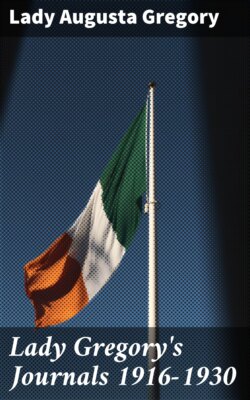Читать книгу Lady Gregory's Journals 1916-1930 - Lady Augusta Gregory - Страница 3
На сайте Литреса книга снята с продажи.
EDITOR’S FOREWORD
ОглавлениеTable of Contents
Augusta Persse was born on March 15th, 1852, in a country house called Roxboro’ in County Galway. She was the youngest daughter of Dudley Persse who at one time owned an estate of nearly four thousand acres. In 1880 she married Sir William Gregory whose house and property, Coole Park, Gort, were only a few miles away. Sir William had had a varied and interesting career. As a young man he was a devotee of the turf and had to sell out thousands of his Irish acres to pay his debts; he nearly fought the last duel in England (saved from it by Sir Robert Peel’s intervention); he became an M.P., fell under the spell of Daniel O’Connell and became a notable and well-beloved Governor of Ceylon. His “Autobiography”, originally printed only for his friends’ eyes, is one of the most honest I have read, as honest as that of his friend, Anthony Trollope. He died in 1892. Augusta Persse was his second wife. He had no issue by his first wife; by his second he had one child, Robert, who became a distinguished painter but met his death as an airman flying over Italy during the war of 1914-18. Robert married Margaret Lucy Maynard Perry, and had three children, Richard, Anne and Catherine. The grand-daughters are the “chicks” so often and so lovingly written about in the Journals.
The Journals start at the end of 1916. This was after her nephew, Sir Hugh Lane, had been drowned in the torpedoing of the “Lusitania”, and their first purpose seems to have been to record the complicated negotiations she undertook to achieve the return of the “Lane Pictures”. And so the first couple of years are chiefly concerned with that subject. But, later, other interests impinged: the Anglo-Irish War, the Civil War, Coole Park itself and little local agrarian disputes.
The Journals comprise approximately five hundred thousand words and it has not been an easy task to abridge them to about one hundred and forty thousand. Somewhere she has said that she would like them to be published in sequence, but in 1928 she writes:
“Well, I don’t know why to-day that sentence about Rossetti has seemed to set me on a path towards arranging this scrappy diary that must have some words or scenes that might be worth preserving—but an idea came that I, being a playwright, might dramatise myself, give separate scenes (though the fall of the curtain will be arranged by Another and there will be no call to bring me before it!). I wrote down quickly with a pencil my different parts: ‘A Questor,’ the long begging for Hugh’s pictures; yes, I have been a beggar at many doors.... Then I change and appear as a Theatre Director, I may find enough letters to and from Yeats and others to make this lively though I wish I could give those from Miss Horniman about her ‘Irish toy.’ As playwriter, there is not much to say—some at least continue to be seen for themselves and heard. Gaelic Leaguer also, with that little badge sent me across the seas by Father O’Growney. But I think I have told this in the diaries or chapters Putnam—Huntington—has charge of. And then ‘a rebel’ with the Nationalists all through—more than they know or my nearest realised. And the heartbreak of our Civil War!”
This is the method I have followed. Apart from drastic abridgment the only alterations I have made are sometimes to substitute a name for initials, for the reader’s better understanding. She left a written request that this should be done. During her last years she typed her old Journals, (thank goodness, for she wrote a dreadful hand,) and deleted anything that she thought might give pain. There are a few “hits, cuts and thrusts,” (a phrase she liked to use,) and I think the sharpest are directed against myself. I have not hesitated to use them. I think I have omitted only one hit at me which was not very severe and of no general interest.
Lady Gregory had a most accurate memory: She spent years collecting folk-lore in cottage and farmhouse, in workhouse-ward or where-ever. That folk-lore rings authentic and so I think we can take the conversations she reports as truth—John Dillon’s long and interesting talk at Kilteragh (page 169), for instance.
But I am sure I have omitted much that to others will seem very important and when this book is published I hope her heirs will deposit these forty-two typewritten volumes in our National Library for others to read and find cause to blame me. Before many months have passed perhaps my Biography of her will be in print; that book and this are complementary.
Many people have helped me and have my thanks. Mr. P. S. O’Hegarty has kept me historically correct about our wars, Dr. Thomas Bodkin about the Lane Pictures. Mrs. Yeats has given permission to use W. B. Yeats’ poems on pages 45, 238, 263 and 266; Mr. G. Bernard Shaw for his poem on page 18, and “Paul Jones” for his poem on pages 234-5. And thanks to Messrs. Macmillan & Co. for permission to use Hardy’s poem on pages 12 and 13. And I thank all the writers of letters quoted in her Journals for permission to reprint them.
Lennox Robinson.
